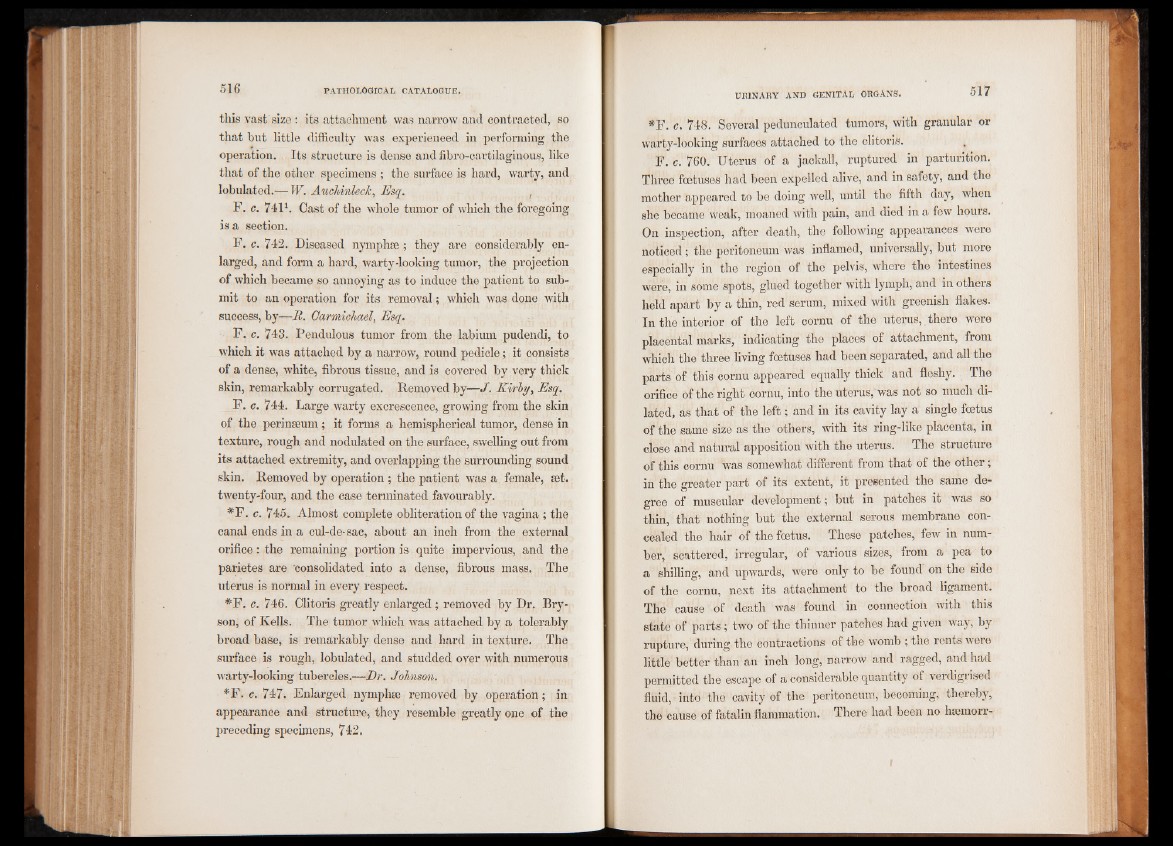
this vast size : its attachment was narrow and contracted, so
that but little difficulty was experieneed in performing the
operation. Its structure is dense and fibro-cartilaginous, like
that of the other specimens ; the surface is hard, warty, and
lobulated.— W. Auchinleck, Esq. t
F. c. 7411. Oast of the whole tumor of which the foregoing
is a section.
F. c. 742. Diseased nymphse ; they are considerably enlarged,
and form a hard, warty-looking tumor, the projection
of which became so annoying as to induce the patient to submit
to an operation for its removal; which was done with
success, by—11. Carmichael, Esq.
F. c. 743. Pendulous tumor from the labium pudendi, to
which it was attached by a narrow, round pedicle; it consists
of a dense, white, fibrous tissue, and is covered by very thick
skin, remarkably corrugated. Removed by—J. Kirby, Esq.
F. c. 744. Large warty excrescence, growing from the skin
of the perinseum; it forms a hemispherical tumor, dense in
texture, rough and nodulated on the surface, swelling out from
its attached extremity, and overlapping the surrounding sound
skin. Removed by operation ; the patient was a female, set.
twenty-four, and the case terminated favourably.
#F. c. 745. Almost complete obliteration of the vagina ; the
canal ends in a cul-de-sac, about an inch from the external
orifice: the remaining portion is quite impervious, and the
parietes are consolidated into a dense, fibrous mass. The
uterus is normal in every respect.
#F. c. 746. Clitoris greatly enlarged; removed by Dr, Bryson,
of Kells. The tumor which was attached by a tolerably
broad base, is remarkably dense and hard in texture. The
surface is rough, lobulated, and studded over with numerous
warty-looking tubercles.—Dr. Johnson.
*F. c. 747. Enlarged nymphse removed by operation; in
appearance and structure, they resemble greatly one of the
preceding specimens, 742.
*F. c. 748. Several pedunculated tumors, with granular or
warty-looking surfaces attached to the clitoris. t
F. c. 760. Uterus of a jackall, ruptured in parturition.
Three foetuses had beén expelled alive, and in safety, and the
mother appeared to be doing well, until the fifth day, when
she became weak, moaned with pain, and died in a few hours.
On inspection, after death, the following appearances were
noticed ; the peritoneum was inflamed, universally, but more
especially in the region of the pelvis, where the intestines
were, in some spots, glued together with lymph, and in others
held apart by a thin, red serum, mixed with greenish flakes.
In the interior of the left cornu of the uterus,. there were
placental marks, indicating the places of attachment, from
which the three living foetuses had been separated, and all the
parts of this cornu appeared equally thick and fleshy. The
orifice of the right cornu, into the uterus,'was not so much dilated,
as that of the left ; and in its cavity lay a single foetus
of the same size as the others, with its ring-like placenta, in
close and natural apposition with the uterus. The structure
of this cornu was somewhat different from that of the other ;
in the greater part of its extent, it presented the same degree
of muscular development ; but in patches it was so
thin, that nothing but the external serous membrane concealed
the hair of the foetus. These patches, few in number,
scattei’ed, irregular, of various sizes, from a pea to
a shilling, and upwards, were only to be found on the side
of the cornu, next its attachment to the broad ligament.
The cause of death was found in connection with this
state of parts; two of the thinner patches had given way, by
rupture, during the contractions of the womb ; the rents were
little better than an inch long, narrow and ragged, and had
permitted the escape of a considerable quantity of verdigrised
fluid, into the cavity of the peritoneum, becoming, thereby,
the cause of fatalin flammation. There had been no hæmorr